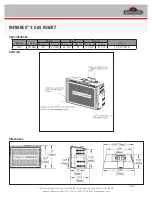
45
44
User Manual
10
FREQUENT
SCENARIOS
The following is a list of common questions and concerns regarding system setup,
battery charging and maintenance procedures. Please refer to these as general guide-
lines. For further assistance with your specific system setup, please contact your In
-
staller.
WHEN A CHARGE IS INITIATED THE VOLTAGE OF THE BATTERY BANK RISES VERY
QUICKLY AND THE CHARGER GOES QUICKLY INTO THE ABSORPTION CHARGE
CYCLE OR SHUTS OFF CHARGE TO THE BATTERIES COMPLETELY.
• This is often an indication of sulfated batteries which may be causing a higher than
normal internal resistance. Capacity of the bank will be reduced and can be confirmed
by running a load test.
• An increase in Absorption time may be necessary to de-sulfate the battery bank.
• If the battery bank is heavily sulfated, a corrective equalization may be necessary
Perform a corrective equalization if specific gravity readings vary by more than 0.015
between cells.
BATTERY TERMINAL HAS MELTED
• This is most common with loose connections, causing a highly resistant connection
This resistance has caused heat buildup and melted the terminal connection.
• Loose connections
• Over-tightened connections
• Improper sized cables (too small).
• Corroded connections
• Improper use of washers/lock washers.
• Too many connections on the same terminal
BATTERY(S) TEMPERATURES ARE VERY HIGH.
• If at or near 50˚C (120˚F) shut off charge and allow batteries to cool.
• If a single battery or cell in a string is hot, this may indicate a cell failure or short. Verify
specific gravity for all cells and take voltage readings from each battery and perform a load
test to identity any cell failures and verify proper cell operation.
SPECIFIC GRAVITY READINGS AT FULL CHARGE VARY SIGNIFICANTLY, (>0.015)
• This may be caused by multiple parallel strings of batteries in a bank, which often result in
charge imbalance. It is not recommended that a system exceed 3 strings of batteries
connected in parallel.
• Charge voltage settings may be too low. Verify they meet US Battery recommended
charging parameters for Flooded or AGM models.
• An increase in Absorption charge time may be necessary. Increase in 15 to 30 minute
increments.
• Indicates there may be failing or dead cell(s) in the battery bank causing a charge
imbalance.
BATTERY CASES ARE BULGING ON THE SIDES.
• Batteries bulge up on the sides as they age, this is completely normal and expected.
• Due to the weight of electrolyte, some case bulging is normal.
• New battery cases will “relax” after filling. Verify that electrolyte levels have not
dropped below the top of the plates before attempting to charge and top up with distilled
water as necessary.
• In the case of excessive bulging- your batteries may have been exposed to
temperatures of over 50°C (120°F). This high temperature has caused the plates/chassis to
swell and expand. There is no fix for this and eventually the batteries will fail prematurely.
• Your batteries may have frozen due to excessive cold temperatures. A fully charge battery
(specific gravity of 1.265) may freeze at -70°C (-94°F) or more. A battery that is at 50% state
of charge (specific gravity of 1.150) may freeze at -10°C (15°F).
CAPACITY(RUNTIME) OF THE BATTERY BANK HAS DECREASED.
• Capacity loss may be due to sulfation. A balance charge and/or equalization may be
necessary.
• Capacity loss may be due to overheating. Verify that temperature sensors are properly
mounted and verify cell temperatures.
• Capacity loss may be due to over-discharging the battery bank. Capacity of the battery bank
may no longer support an increase in load.
• Capacity loss from aging batteries. Towards end of life, batteries initially will slowly drop in
capacity until 50% capacity. At this point US Battery recommends battery replacement.
SPECIFIC GRAVITY READINGS ARE CONSISTENTLY HIGHER THAN
RECOMMENDED. (>1.300)
• Charging voltages may be too high and/or Absorption time should be decreased to
prevent overcharge. Usage may have decreased, reducing depth of discharge (DOD
and the time required to recharge, causing the batteries to overcharge.
• Decrease Bulk/Absorption Voltage in 0.2v volts increments.
• Decrease Absorption Time by 30 minutes increments as necessary.
SPECIFIC GRAVITY READINGS OF ALL CELLS IN THE BATTERY BANK INDICATE
LOW STATE OF CHARGE. READINGS VARY BY CELL, BUT NOT GREATER THAN
.015 BETWEEN THE CELLS.
• Charging voltages may be too low and/or Absorption time may need to be increased to
prevent undercharging. Usage may have increased, resulting in increased depth of discharge
(DOD) and sulfation.
• Increase Bulk/Absorption/Boost Voltage in 0.2v volts increments.
• Increase Absorption Time by 30 minutes increments as necessary





































